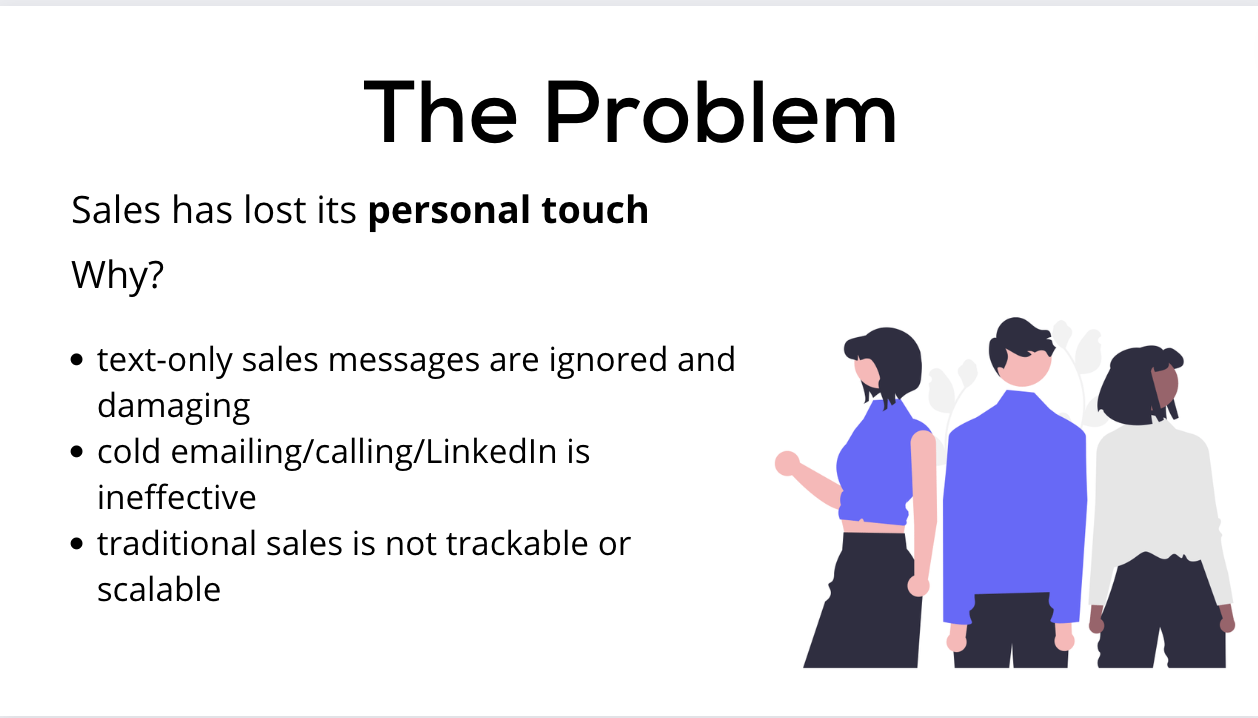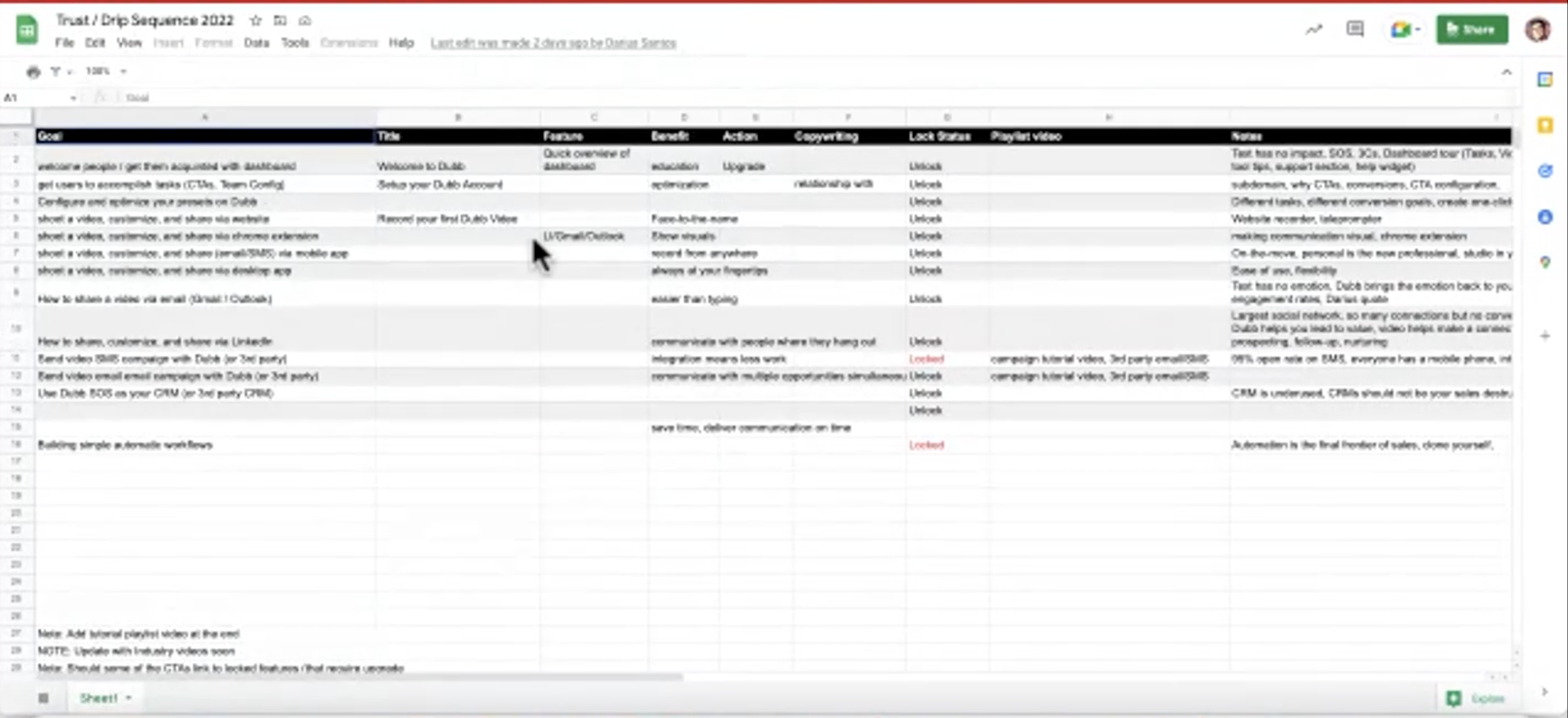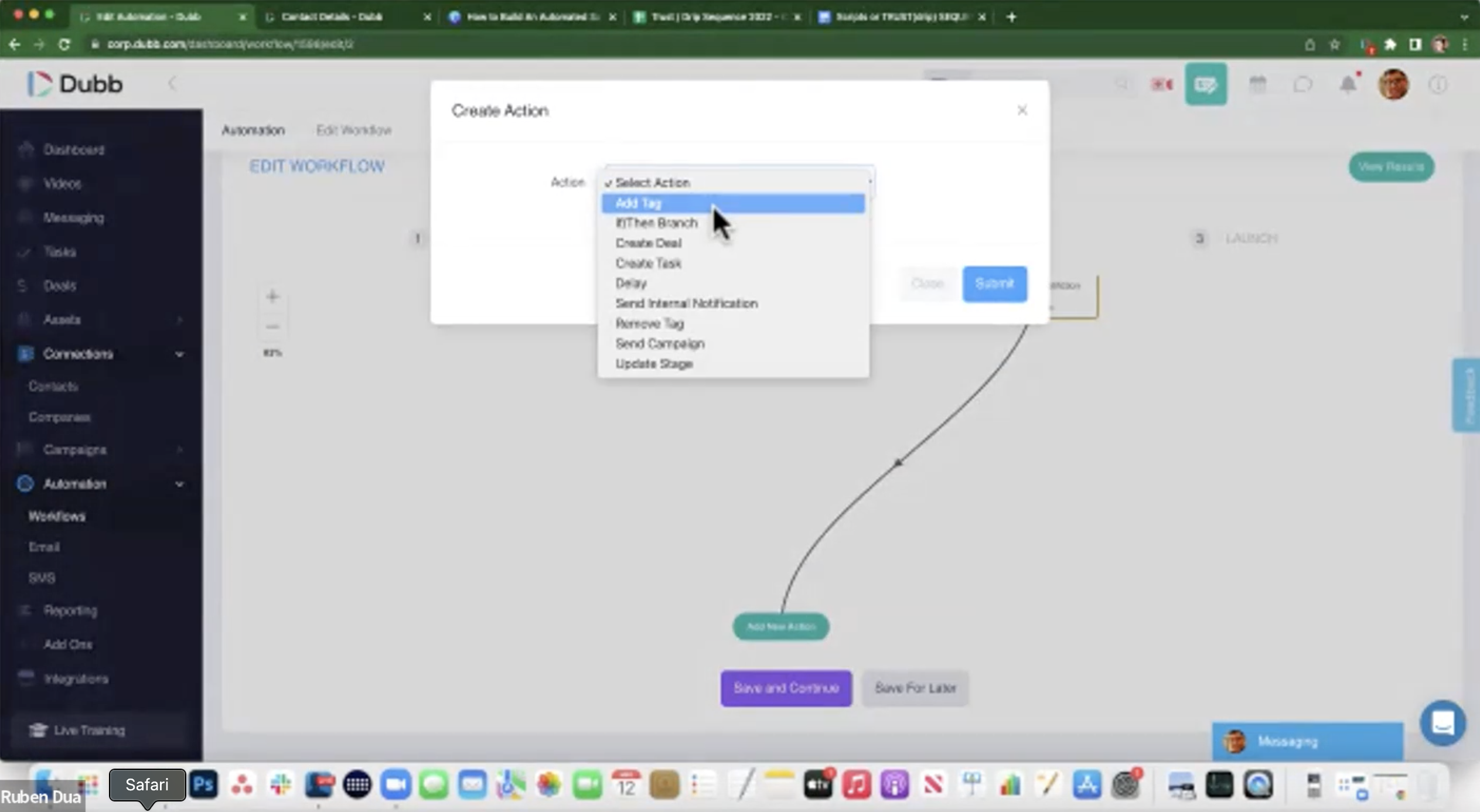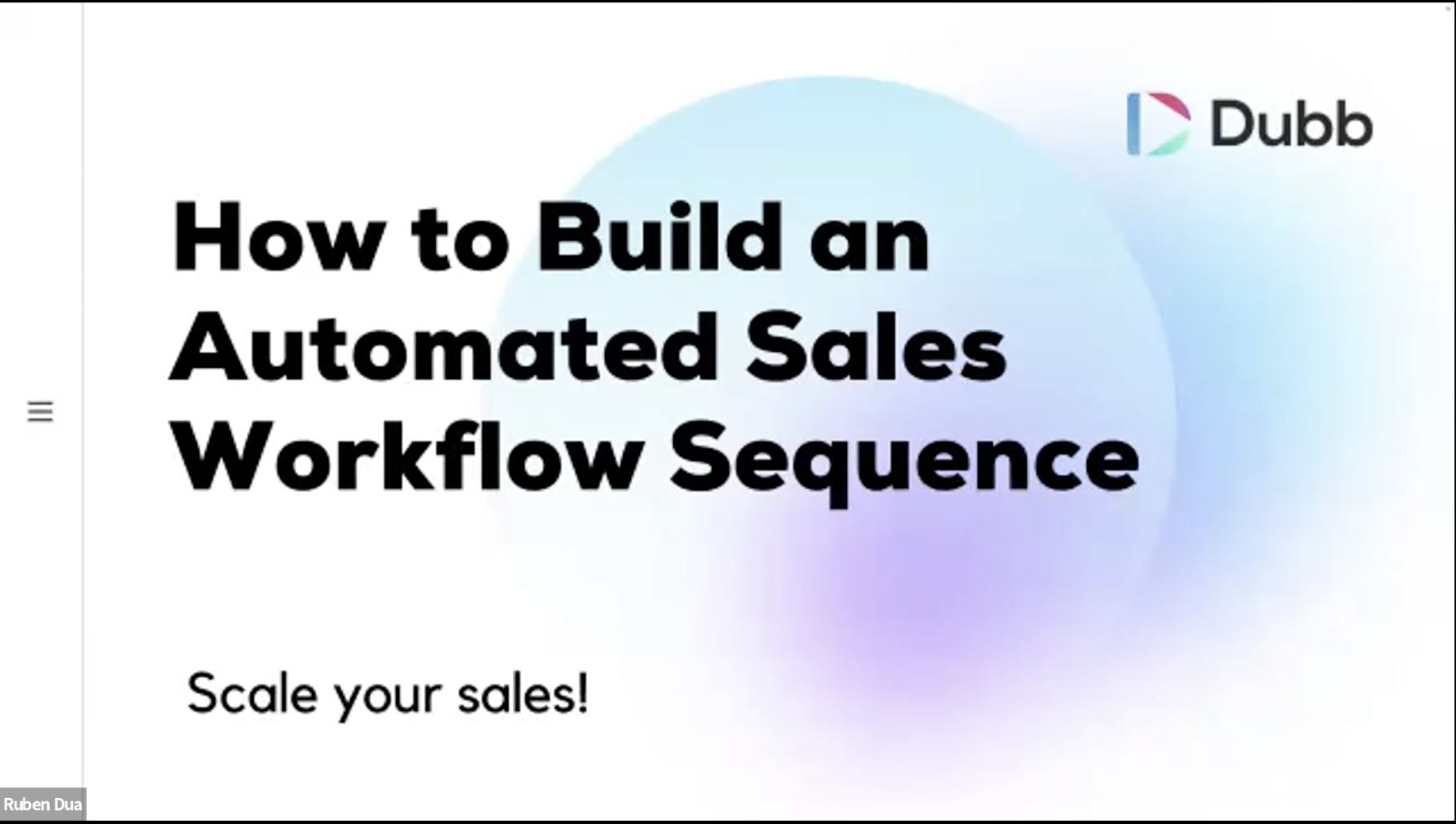Have you been searching for an easy and effective way to create an automated sales workflow for your business? Or have you been trying to create an automated sales workflow, yet you aren’t seeing the progress that you’d like to be seeing?
At Dubb, we understand how frustrating or daunting it can be to create a great automated sales workflow. Especially if you are not comfortable with technology, figuring out how to create your workflow and optimize it for your needs. It is all too easy to give up and forego this great opportunity to seamlessly engage with your audiences.
Because of this, I want to take this time to discuss automated sales workflows and how you can create stellar workflows for your organization. Whether you are just hearing about automated sales workflows for the first time or are looking for a way to make better automated workflows, you can use this guide to build that awesome sales workflow and generate more sales.
So are you ready? Let’s take a deep dive into automated sales workflows and how they can help you grow your business.
Automated Sales Workflows: The Basics
Before discussing the why, it is important to talk about what automated sales workflows are. It is helpful to break it down into the two component parts:
Let’s start with a “sales workflow.” Basically, a sales workflow is a defined set of steps that guides a prospect from inception to purchase. In fact, most sales workflows go beyond the purchase in order to maintain an ongoing relationship with the customer (and, consequently, generate even more sales). But putting that aside, you can think of a sales workflow as getting from point A (meeting a prospect) to point B (getting that prospect to make a purchase). It involves all of the steps that lead to that awesome conclusion (the sale).
As you can imagine, a sales workflow can be simple or complex. In some circumstances, you may see a company release a highly elaborate flow chart with plenty of arrows, lines, and circles. In others, there may be a single-digit number of steps. At their core, however, these sales workflows focus on things like researching your prospects, qualifying potential customers, overcoming objections, closing the deal, and more. Ultimately, a great sales workflow is repeatable. From the most experienced sales employee to the newest hire, every member of the sales team should be able to understand and implement the sales workflow.
Now, let’s talk about “automated.” This is pretty straightforward. In this context, it is the idea of letting technology execute some (or many) parts of your sales workflow. You and your sales team can do this by leveraging Dubb or another platform. After putting in some initial work, you can sit back and let technology do what it does best.
Automation is becoming a bigger and bigger part of all of our lives. Because of this, it is extremely beneficial to let technology do many of the basic tasks within your sales workflows. By doing so, it can free up some of your valuable time and let you focus on the more important tasks throughout your day.
Why Automated Sales Workflows Are So Powerful
With this understanding of automated sales workflows in mind, let’s talk about why you should care. After all, you’re certainly busy with your day-to-day responsibilities at work. If you are going to add on additional work, you want to make sure that it adds significant value to your organization.
While there are plenty of reasons why automated sales workflows are so powerful, we want to discuss only a few of them here.
Most prominently, automated sales workflows can help you get more customers. For most people, this is the number one goal. The great news is that these workflows can help you generate more business—whether you run your own startup or work at a much larger company.
How do automated sales workflows do this? Essentially, they let you seamlessly leverage a well-thought list of steps to nurture a customer relationship. Guiding a prospect through your sales workflow, you can maximize your chances of persuading that individual to become a paying customer. You can increase your odds that the prospect is qualified, sees how your product or service can create immense value in their life, and minimizes any potential objections that emerge. Not only that, but automated sales workflows maximize your impact with a larger audience. In other words, you can scale more easily, meaning that all of the effort and work that you put into your sales workflow continuously provides value in the future.
Granted, automated sales workflows aren’t a silver bullet. They don’t guarantee that you’ll transform every prospect into a paying customer. Simultaneously, however, they give you an outstanding chance to generate more revenue and grow your business. No matter the business that you’re in, you can use automated sales workflows to build better relationships with your customers and reach your sales goals. You can even have millions of people in your automated sales workflow. It’s that scalable.

Along with helping you get more customers, automated sales workflows offer plenty of data. This data is extremely powerful. Seeing how prospects have interacted with your sales workflow lets you create even more automated sales workflows in the future. You get to see how your prospects really react when you and your colleagues attempt to sell them your product or service.
An example is helpful here. Let’s say that you created a basic automated sales workflow that targets prospects that clicked on one of your online ads. Once a prospect clicks on the ad and submits their email address on one of your online forms, you send that prospect a personalized email. In that email are several call to action (CTA) options, including an option to download an eBook and an option to call you. By leveraging this automated process, you can get valuable analytics on how your prospects are moving down your sales funnel. For instance, if you are seeing that your CTA buttons aren’t receiving as much activity as you expected, you may want to change the wording. You can use things like A/B testing to determine which copy leads to the highest conversions.
This is just one example, but it goes to show how data can help enhance your sales workflows. So long as you are paying attention to it, this constant stream of data can provide immense value to your business.
One of the key benefits of automated sales workflows is that they save you time. This is an absolutely huge factor that can create immense value for your business. Because automated sales workflows are automated, you don’t need to spend time on simple and repeatable tasks. For instance, if you met an exciting new prospect that is interested in making a purchase from your business, you can invite that prospect to complete a form online. From there, she can be entered into your sales workflow, which can automatically send her literature about your product or service. That workflow can make it easy for her to schedule a call on your calendar. That workflow can even send reminders to that prospect, gauging her interest in your product or service and arranging a follow up communication as necessary.
Because we are living in such a busy world, it is critical to work on tasks that provide the most value to your organization. Automated sales workflows can help you clear up your calendar and spend time working on the most accretive tasks for your business’s future. This is in contrast to one-to-one sales. While one-to-one sales can be valuable to your business, it isn’t as efficient. It isn’t scalable, while automated sales workflows are.
Finally, a key benefit of automated sales workflows is immediacy. This may not be something that immediately comes to mind, yet immediacy plays an important role in converting a prospect into a paying customer. There is plenty of data showing that if we reach out to prospects within five minutes, we have a much higher chance of closing that deal. I think the reason why that’s the case is that people like good customer service. They like the idea of when reaching out to a company or organization, they will receive a prompt (and helpful) response.
Automate sales workflows are great at providing this immediacy. For instance, after a prospect completes a form on your website, you can automatically send her valuable information about your product, service, or company. You can even create a CTA that lets that prospect connect with your organization through Facebook Messenger. Whatever you choose, you can make sure that all of your prospects are being immediately responded to.
Building an Automated Sales Workflow With Dubb
At this point, we have covered a few very important topics. We discussed what automated sales workflows are and how they can create massive value for you, your colleagues, and your organization. Whether you work for a small or large organization, you can use an automated sales workflow to accomplish your goals.
Now, let’s talk about how you can build an automated sales workflow for yourself. I would guess that around less than 10% of sales professionals use any type of automated sales workflow. Going further, I would estimate that less than 5% of sales professionals are using them well. There is a massive opportunity here for all types of businesses and organizations to leverage the power of automated sales workflows.
While there are many tools to help you do this, I want to talk about Dubb. Dubb is the sales operating system that lets you do a whole host of things. Essentially, it comes down to what I call the “three Cs.” Those three Cs are Connect, Converse, and Convert. Dubb is a sales-first technology platform that can help you build great relationships with prospects and generate more sales. Our entire team understands the power of automated sales workflows, so we created tools that can help you create awesome workflows for your own business.
The Power of Video
So what makes Dubb’s automated sales workflows so powerful? There are many reasons, but I think it comes down to one important factor. That factor is that these workflows rely on a video-first strategy.
If you have been following Dubb for some time, you know how obsessed we are with the power of video. Video is so effective in helping you capitalize on these three Cs (connections, conversations, and conversions). Compared to text-based communication, video makes it easier to create authentic, long-term relationships with your audience. It makes it easier to have real conversations with these individuals, whether you are communicating at the same time or are communicating asynchronously. And as far as conversions, Dubb makes it much easier to convert your prospects into paying customers. It was designed for sales professionals like you who want to create great relationships and grow your organizations. Ultimately, video converts, so you’ll definitely want to take advantage of it when creating your sales workflows.
The great news? You don’t need to be a technical expert to create an awesome sales workflow. You don’t need to obtain any type of certification. Instead, you can use Dubb to create any type of sales workflow that you need. Better yet, these sales workflows are scalable and personal at the same time. You and your colleagues get to leverage both benefits as you work to reach your goals.
Places to Leverage an Automated Sales Workflow
So what do you need to create that awesome automated sales workflow? I think it’s helpful to think about creating automated sales workflows in the context of different use cases. Those use cases include prospecting, follow up, nurturing, client communications, testimonials, and referrals. Let’s talk about each of these in some more detail.
Prospecting: There are ways to automate your prospecting. Typically, there is some sort of manual reach-out, whether that is through LinkedIn, an email, SMS, or something else. The way that you can automate this in prospecting is to use tags in your contacts. With Dubb, you can even send personalized video messages to your prospects, drastically increasing your chances of building strong relationships and generating sales.
Follow Up: An automated sales workflow is super helpful when following up with prospects. Let’s say that you haven’t heard from an important prospect in some time. In fact, you sent her a high-value piece of content, but she has not responded to your outreach. In that situation, you can ignore it and hope that they somehow get nurtured.
A much better path, however, is reaching out through an automated workflow. This can be something that is time-sensitive. You can create a rule, for instance, where if that prospect hasn’t responded within one week, Dubb will automatically send a follow-up video message. With this video message prerecorded, there is nothing that you’ll need to do to follow up with that prospect.
Nurturing: Nurturing is about continuing to provide value to your prospects and customers. At Dubb, we believe that the best way to nurture individuals is to nurture them with valuable content. If you haven’t yet heard back from a prospect, that probably means that they haven’t been sold yet. You can further nurture that relationship by sending them valuable videos, PDFs, podcast episodes, or any other relevant asset that you may have.
Client Communications: This can include everything from updates on your platform, solutions, client services, or something else. Using Dubb, you can create drip sequences (at Dubb, we call them trust sequences) for your existing clients. Ultimately, we want our clients to email us, call us, text us, and reach out when they want. That being said, if we already have answers to some of the questions that they may have (whether they are in the form of YouTube videos or something else), you can automatically provide those resources to them. In effect, they can self-educate with that content and reach out to your organization when they need personalized help.
Testimonials: Testimonials are a huge asset for your business. They leverage one of the most powerful things in sales: word of mouth. When you have satisfied customers organically speaking about your product or service, you are much more likely to see increased sales. Reviews really mean the world, whether they are shown on your website or on platforms like Capterra. Using Dubb, you can automate the process of gathering testimonials. As part of your workflow, you can ask someone to leave a testimonial after some positive action (most naturally, after that person makes a purchase). That ask can come in video form, where you sincerely articulate your appreciation of their purchase and ask for a very brief video testimonial. Using Dubb, that individual can press one button, record their thoughts, and send the testimonial back to you.
Referrals: Finally, you can use Dubb to get referrals from your automated sales workflows. Referrals are another great way to find new customers. In fact, they have around a 7X increase in conversion rates. Again, you are leveraging social proof here. While there are early adopters, many of us don’t want to be guinea pigs. We don’t want to waste our time, so because of this, referrals can be a great addition to your automated sales workflow.
What We Do at Dubb
To better illustrate how automated sales workflows work in practice, I want to share some of the things that we do at Dubb. Granted, all of us can improve our automated sales workflows. Perfection is impossible to achieve. At the same time, however, I think it may be helpful to share how we operate under the hood.
For starters, we have a spreadsheet that we use when creating every automated trust sequence. When someone signs up for Dubb, we have a daily video for that newly signed up individual. My colleagues and I go through the entire buying journey of what we want each prospect to do to become Dubb subscribers. In the spreadsheet, you can see that we have columns for the goal, title of the video, the feature that we want to focus on, the benefit that the prospect will obtain, and more. We even track whether we want to add a playlist video to that initial step, which is a secondary video that can autoplay for that prospect.

The most important idea here is planning in pre-production. When it comes to video, planning is something that I had to learn how to do. I used to grab my phone and speak off the cuff, hoping that an editor would help me hone in on the message. Now, however, my team and I have really embraced storyboarding. Storyboarding helps us record something without needing to be stressed about memorizing our content or expressing everything that we want to express.
From the spreadsheet, we go to a script-like document and don’t use teleprompters. Teleprompters not only are more difficult, but viewers can see the eyelines. They know that you’re speaking off of a teleprompter, making it much more difficult to create a genuine connection with them. Instead of a teleprompter, we create outlines. The outlines have bullets of material that we thoroughly know. We then have a dry run (perhaps even a web run, which means that we record the attempt). Then, with production and editing, we can get a very clean take.
Whenever you’re making videos for your automated sales workflow, you’re going to want to embrace the pause button. You’ll find the pause button throughout the Dubb ecosystem, including the Chrome extension, desktop app, and more. On the Dubb mobile app, you can even pause and record individual clips. When recording clips, you don’t need to memorize two to three minutes of content. Instead, you can speak in bursts.
If you are using Dubb to create your automated sales workflows, I highly recommend that you embrace the pause button. Doing so will make your life easier and will help you create more compelling video content.
Creating an Automated Workflow on Dubb
With all of this in mind, I now want to briefly take you through a quick tutorial on creating an automated sales workflow on Dubb. Granted, this isn’t a complete tutorial. If you want to learn more, I encourage you to either try it out for yourself or contact our team with specific questions.
The first thing that you’ll want to do is click on the automations tab on your Dubb dashboard. From there, you’ll want to create a title for your workflow. You’ll then want to create some sort of trigger. One of my favorite triggers is called “tag added.” When you go to one of your contacts on Dubb, you can add a tag to that contact. If you add that tag, it can trigger an automatic workflow. For instance, if you meet someone at a conference, you can go to the Dubb mobile app or Dubb website, add a tag to their name, and trigger the workflow (which you already created). This is a great way to start combining both manual and automated work in nurturing and converting your prospects.
Once you have selected your trigger, you can then build your workflow. You not only select how the workflow is triggered, but you can select any internal notifications, emails that you may want to send out to the target, and more. There are plenty of ways to manage this, and the best way to find out is to play with the software. As you start to practice with your workflows, you’re going to get more intelligent with the decisions that you make. You’ll create decision trees that can include things like if/then branches, the ability to track deals, create a task, add a delay, send an internal notification, remove a tag, send a campaign (through SMS or something else), and update the deal or lifecycle stage.

Building a workflow does take some time and experience. If you are feeling intimidated, you can always reach out to a coach or another expert to help guide you through this process. However, if you keep working on your workflows and experimenting with the software, you’ll gain confidence and develop the skills to create the best possible workflows for your organization.
After you have created your great workflow, you will need to launch it. There are a few switches that you’ll need to account for. There is a switch for only triggering the contacts once, which means that the contact doesn’t necessarily need to go through the trust sequence again. Then, there is the off/on switch. Once you’re done building and iterating, you can turn on your workflow and start automatically engaging with your prospects. If you need to make any edits, you can always turn off the workflow.
The Power of the Automated Sales Workflow
Automated sales workflows can supercharge your business. They are about taking a message, determining ways to intelligently track the customer journey, and then triggering automated sequences to get more of the three Cs.
So go ahead and get started building some automated sales workflows. Start simple and go ahead and make them more complex as you get more experience. I can’t wait to see what you create!


